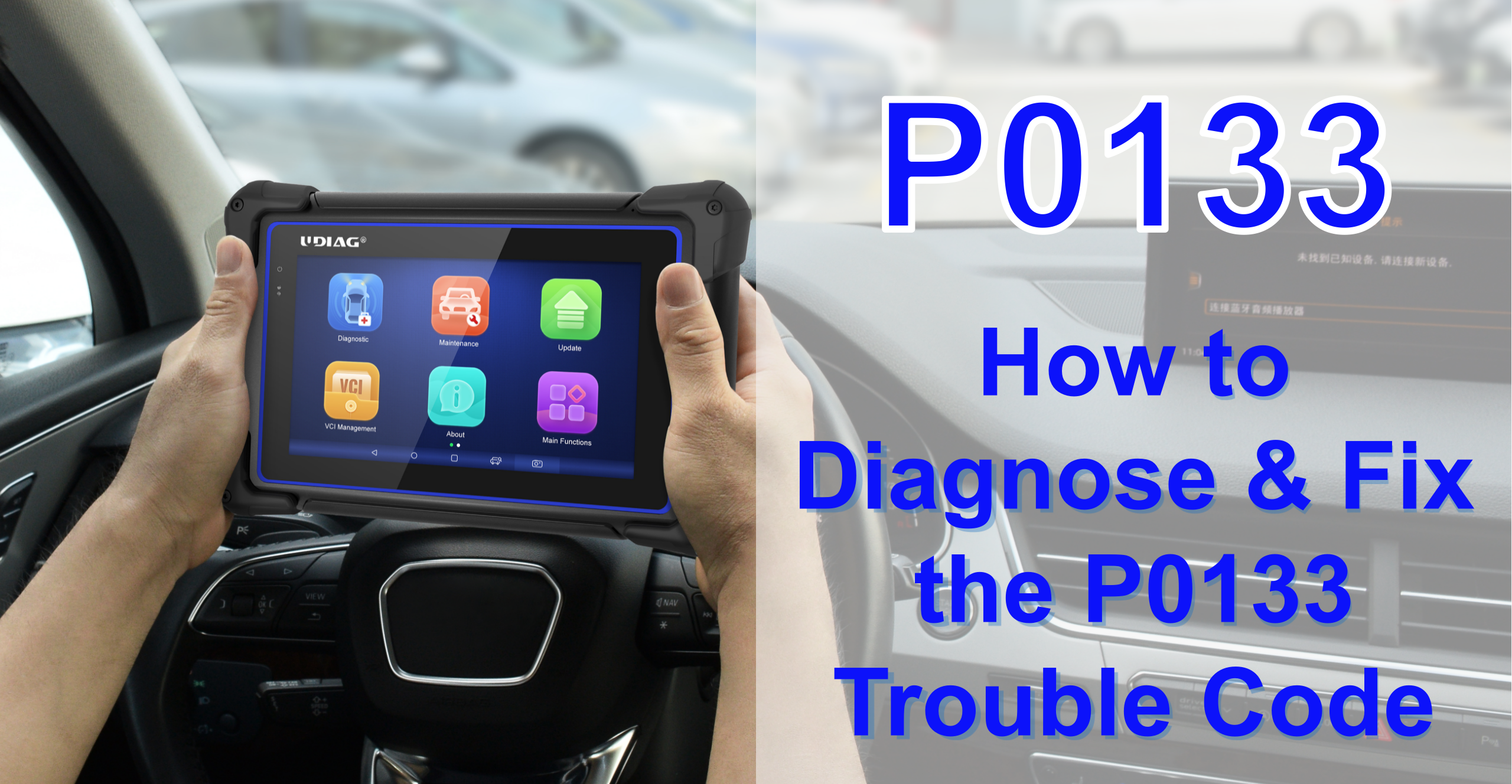How to Diagnose and Fix the P0133 Trouble Code
2023-05-31 by UDIAG
The P0133 trouble code is an important diagnostic code that can provide valuable insights into the health of the oxygen sensor in a vehicle’s exhaust system. Understanding the meaning, symptoms, and consequences of this code is crucial for both vehicle owners and technicians. In this article, we will delve into the details of the P0133 trouble code, explore its symptoms, discuss the potential repercussions of ignoring it, and provide practical tips for diagnosing and fixing the issue. By gaining a comprehensive understanding of the P0133 code, readers will be better equipped to address it effectively and maintain their vehicle’s performance and emissions control.
What Does the P0133 Code Mean
The P0133 code is triggered when the engine control module (ECM) or powertrain control module (PCM) detects that the voltage readings from the oxygen sensor bank 1 sensor 1 are not within the expected range or that the sensor’s response time is slow. The oxygen sensor is a crucial component that monitors the air-fuel mixture in the engine and provides feedback to the ECM/PCM for optimal fuel efficiency and emissions control. By understanding the significance of the P0133 code, we can appreciate the importance of addressing it promptly to maintain the vehicle’s performance and environmental compliance.
Symptoms of P0133 Trouble Code
The P0133 trouble code is associated with specific symptoms that indicate a potential issue with the oxygen sensor. These symptoms serve as warning signs to alert vehicle owners and technicians to a potential problem. Here are some common symptoms of the P0133 trouble code:
- Decreased Fuel Efficiency: One of the primary symptoms is a noticeable decrease in fuel efficiency. The oxygen sensor plays a crucial role in monitoring the air-fuel mixture, and if it is not functioning properly, it can result in an inaccurate mixture, leading to poor fuel economy.
- Rough Idle: A rough or unstable idle is another symptom of the P0133 code. The improper air-fuel mixture can cause the engine to run unevenly at idle, resulting in a rough or shaky idle sensation.
- Poor Engine Performance: The P0133 code can negatively impact the overall performance of the engine. You may experience a lack of power, sluggish acceleration, or difficulty maintaining consistent speed. The engine may feel less responsive or struggle to perform optimally.
- Failed Emissions Tests: When the oxygen sensor is not functioning correctly, it can lead to increased emissions. As a result, the vehicle may fail emissions tests conducted during mandatory inspections. The P0133 code indicates a problem with the oxygen sensor’s response time or voltage readings, which can contribute to higher pollutant emissions. Failing emissions tests not only poses legal implications but also indicates that the vehicle is not operating within environmentally acceptable limits.
- Check Engine Light: The most obvious symptom of the P0133 code is the illumination of the check engine light on the vehicle’s dashboard. The check engine light serves as a warning indicator for various issues, including problems related to the oxygen sensor. Once the ECM/PCM detects a fault in the oxygen sensor’s performance, it triggers the check engine light to alert the driver of a potential problem.
It is important to note that while these symptoms are commonly associated with the P0133 code, they may also be indicative of other issues. Therefore, it is recommended to use a diagnostic tool, such as an OBD-II scanner, to retrieve the specific trouble code and gather additional data to accurately diagnose the problem.
If you experience any of these symptoms or if the check engine light illuminates, it is essential to address the issue promptly. Ignoring the symptoms can lead to decreased fuel efficiency, poor engine performance, and potential damage to other engine components. Additionally, failing emissions tests can result in legal consequences and contribute to environmental pollution.
By recognizing and understanding the symptoms of the P0133 code, vehicle owners and technicians can take appropriate measures to diagnose and resolve the underlying issue, ensuring optimal performance, improved fuel efficiency, and reduced emissions.
What Happens If I Ignore It
Ignoring the P0133 code can lead to various negative consequences. Continued disregard for the issue can result in ongoing fuel inefficiency, causing increased costs over time. The improper air-fuel mixture can also impact the engine’s overall efficiency and potentially cause damage to other engine components. Moreover, ignoring the code can result in the vehicle failing emissions tests, leading to potential legal repercussions and contributing to environmental pollution. Understanding the potential implications of ignoring the P0133 code underscores the importance of addressing it promptly.
How to Diagnose and Fix the P0133 Trouble Code
Diagnosing and fixing the P0133 trouble code using the UDIAG X-30 High-end Car Diagnostic Tablet involves the following steps:
- Connect the UDIAG X-30: Connect the UDIAG X-30 diagnostic tablet to the vehicle’s OBD-II port with VCI. The OBD-II port is usually located under the dashboard on the driver’s side. Ensure that the tablet is powered on and properly connected to establish communication with the vehicle’s onboard computer system.
- Retrieve Trouble Codes: Launch the diagnostic software on the UDIAG X-30 and select the option to retrieve trouble codes. The tablet will communicate with the vehicle’s ECM/PCM and retrieve the specific trouble code(s) present, including the P0133 code.
- View Freeze Frame Data: Access the freeze frame data associated with the P0133 code. Freeze frame data captures the vehicle’s operating parameters at the time the code was triggered. Reviewing this information can provide insights into the conditions that caused the code to set.
- Perform Live Data Stream: Use the UDIAG X-30 to access the live data stream from the oxygen sensor. This feature allows you to monitor the sensor’s voltage and response in real-time. Compare the readings to the expected range specified by the manufacturer. Look for any irregularities or delays in the sensor’s response.
- Check Sensor Wiring and Connections: Inspect the wiring and connections of the oxygen sensor. Ensure that the wiring harness is properly connected, free from damage, and securely fastened. Repair or replace any damaged wiring or connectors as necessary.
- Test the Oxygen Sensor: With the UDIAG X-30, you can initiate a test of the oxygen sensor’s functionality. This test allows you to monitor the sensor’s response to changes in the air-fuel mixture and evaluate its performance. Follow the instructions provided by the diagnostic software to conduct the test and interpret the results.
- Check for Exhaust Leaks: Inspect the exhaust system for any leaks or damage. Leaks in the exhaust system can introduce false air, affecting the accuracy of the oxygen sensor readings. Repair any leaks or damage to restore proper sensor functionality.
- Replace the Oxygen Sensor: If all other potential causes have been ruled out and the oxygen sensor is determined to be faulty, it should be replaced. Consult the UDIAG X-30 diagnostic software for instructions specific to your vehicle model and follow the manufacturer’s guidelines for replacing the sensor.
- Clear the Codes and Perform Functional Test: After resolving the issue, use the UDIAG X-30 to clear the trouble codes from the ECM/PCM memory. Once the codes are cleared, perform a functional test by driving the vehicle and monitoring the sensor’s response. Ensure that the P0133 code does not reappear and that the symptoms associated with the code have been resolved.
It is important to refer to the user manual or documentation provided with the UDIAG X-30 diagnostic tablet for detailed instructions specific to the device’s features and capabilities. If you encounter any difficulties or are unsure about the diagnosis or repair process, it is recommended to seek assistance from a qualified automotive technician or consult a professional repair shop.
Conclusion
In conclusion, understanding the P0133 trouble code is crucial for maintaining a vehicle’s performance and emissions control. By recognizing the meaning of the code, its associated symptoms, and the potential consequences of ignoring it, vehicle owners and technicians can take proactive steps to diagnose and address the issue. Promptly resolving the P0133 code through appropriate measures such as cleaning or replacing the oxygen sensor, repairing wiring or connectors, and fixing exhaust



